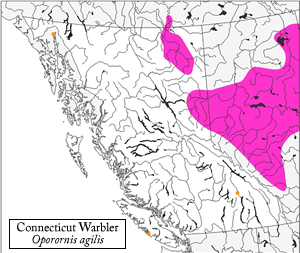The Connecticut Warbler is similar to both MacGillivray’s Warbler and Mourning Warbler in all plumages, especially immatures, but is usually easily distinguished from both species by its narrow, complete white or pale buff eye-ring. MacGillivray’s Warbler is brighter yellow below, has a darker grey hood with blackish lores and a blackish patch on the upper breast, and has a thicker eye-ring that is broken in front and behind the eye to form a pair of “eye-arcs.” In addition, the undertail and uppertail coverts of MacGillivray’s Warbler are noticeably shorter than in Connecticut Warbler, extending only ~1/3 of the length of the tail (extending ~2/3 of the length of the tail in Connecticut Warbler). Most Mourning Warblers, especially on the breeding grounds, can be distinguished from Connecticut Warbler by their lack of an eye-ring as well as their brighter yellow underparts, darker grey hood, and shorter uppertail and undertail coverts (extending ~1/2 of the length of the tail). Many Mourning Warblers, particularly immatures on fall migration, show a narrow whitish or pale buff eye ring that is reminiscent of Connecticut Warbler. The eye-ring is always broken in front of and/or behind the eye, unlike the uniform and complete eye-ring of the Connecticut Warbler.
Connecticut Warbler is also much more terrestrial than either MacGillivray’s or Mourning Warblers, and is often observed walking along the ground. Mourning and MacGillivray’s Warblers rarely venture to the ground, and when they do they move by hopping rather than walking. Vocalizations (both songs and calls) of Connecticut Warbler are very unlike either of the other two species and should be diagnostic if heard.
Source: Dunn and Garrett (1997)
| The song of the male is a loud, ringing, rollicking series of repeated 2- or 3-parted (sometimes 4-parted) phrases, starting slower and softer and building to a stronger, louder, and accelerated middle and end: beecher-beecher-beecher-beecher or chip-chuppy chip-chuppy chip-chuppy chip-chuppy. The song is reminiscent in tone and strength to the song of the Ovenbird or the latter portion of the song of the Northern Waterthrush, while the pattern is similar the song of the Common Yellowthroat. Call notes are heard relatively infrequently and include a sharp peek, a metallic plink, and a softer, nasal chimp or poit; the latter call is often heard in the vicinity of the nest. Also gives a buzzy zeet from flight or from a perch. Source: Dunn and Garrett (1997); Pitocchelli et al. (1997); Sibley (2000) |
Courtship
Courtship and pair formation occurs immediately after arrival on the breeding grounds (late May-early June). Male song is the primary means of courtship. When singing, the male perches at heights of up to 8 m, often from branches within the open subcanopy of deciduous woodlands. The male often sings continuously for prolonged periods (up to several hours) during the height of the breeding season.
Nest
The nest is constructed in June, but little is known about the construction process. The nest is placed on the ground and is well-hidden in thick undergrowth, often at the base of a shrub or small sapling, in a clump of moss, or beneath overhanging dry grasses. The deep, compact nest is ~5 cm across and ~4 cm deep and is composed of fine dry grasses, dry leaves, and stems and is lined with rootlets, plant fibres, and animal hair.
Eggs
Clutches of (3) 4 (5) eggs are laid in late June or early July in B.C. The incubation period is unknown but is probably 12-13 days, and eggs are probably present in B.C. between late June and the third week of July. The smooth, slightly glossy eggs are creamy-white with reddish-brown and paler purplish or greyish-brown speckles and spots; these markings are usually concentrated at the larger end. This species is not known as a host for cowbird parasitism, but this is likely a reflection of the relative difficulty of locating nests and the small number nests that have been studied.
Young
The nestling period is unknown but is likely 8-10 days. Nestlings are altricial, with an orange mouth and yellow gape flanges. The young are tended by both parents, both before and after fledging.
Source: Baicich and Harrison (1997); Dunn and Garrett (1997); Pitocchelli et al. (1997); Campbell et al. (2001)
|
This species is shy, inconspicuous, and secretive when foraging, and is often very difficult to locate. It commonly forages on the ground, bobbing its head back and forth or from side by side while walking and often peering upward. The tail is often bobbed slightly while walking. The terrestrial habits and walking (rather than hopping) means of locomotion are similar to the Ovenbird and very unlike other species in the genus Oporornis. It also forages in shrubs and trees, but maintains the walking gait when moving along branches. Insects and spiders form the bulk of the species’ diet on the breeding grounds and during migration, although seeds and berries are also consumed where they are available. Prey is taken directly from the ground or gleaned from twigs and leaves. It usually forages singly, although loose aggregations of up to a dozen individuals may rarely be encountered during migration.
Source: Dunn and Garrett (1997); Pitocchelli et al. (1997)
|
|

